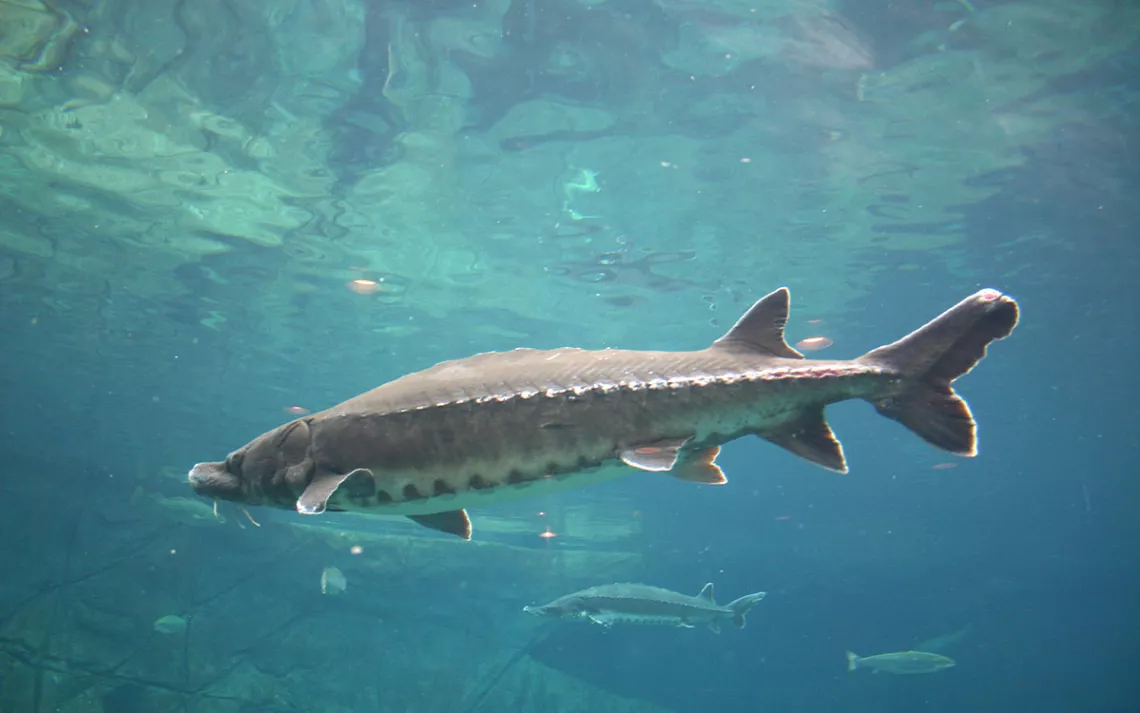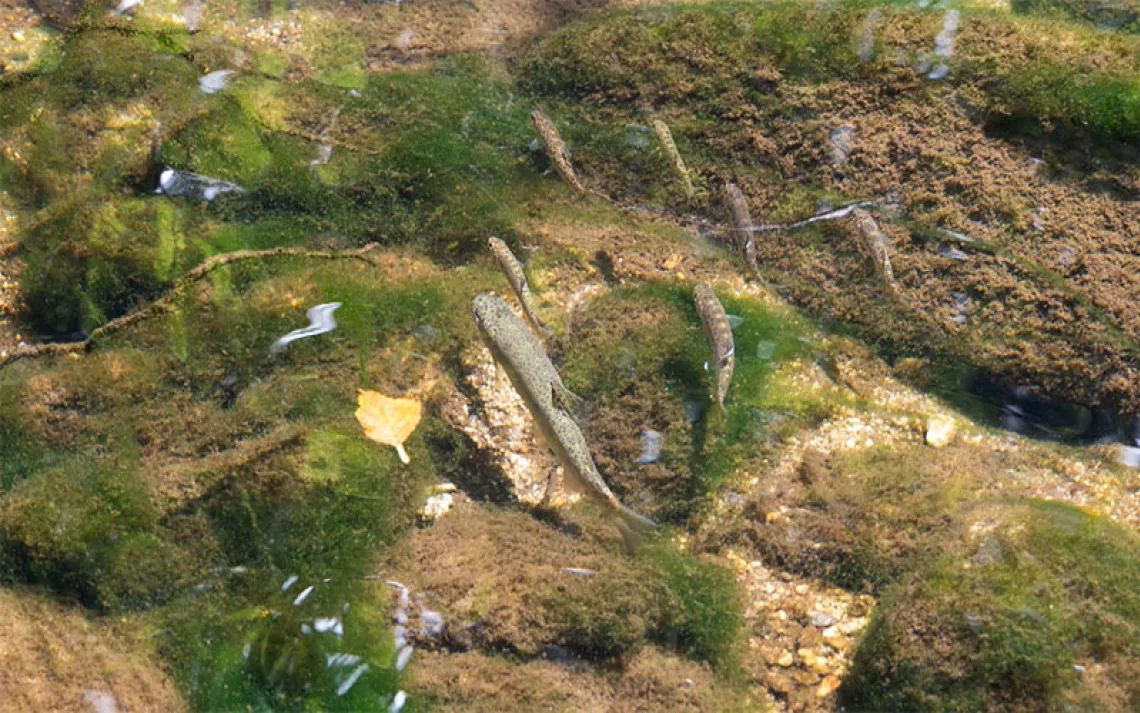Humanity Is Pushing This Prehistoric Fish Toward Extinction
Advocates launch legal fight to protect imperiled Atlantic sturgeon

Atlantic surgeon | Photo by cezars/Getty Images
Last summer, Maya van Rossum, head of the nonprofit Delaware Riverkeeper Network in southeast Pennsylvania, took to Philadelphia’s Independence Mall dressed like a fish. Donning a slate-gray costume with the bony plates and mustache-like barbels of the endangered Atlantic sturgeon, van Rossum assumed the role of “mama sturgeon” and warned anyone who would listen that her babies were in danger. A year later, van Rossum is done playing dress up. Now, she’s suing.
Van Rossum is quirky and energetic. For 30 years as the Delaware Riverkeeper, van Rossum and her colleagues have regularly used the court system to try to knock down activities they feel are detrimental to the river and its ecosystem. This summer, they’ve set their sights on the Environmental Protection Agency as well as the state governments of Delaware, New Jersey, and New York, which they say are failing to protect the Atlantic sturgeon, a species listed as endangered under the Endangered Species Act since 2012.
In July, the riverkeepers sent a notice of intent to sue (a legally required, 60-day precursor to filing an actual lawsuit) to the three state governments for alleged failures to properly limit sturgeon bycatch by commercial fishing operations. More recently, in early August, they announced their intent to sue the EPA, claiming the agency is overdue in creating new water regulations to boost sturgeon reproduction in the Delaware River.
“Every species is worth fighting for,” van Rossum said in an interview with Sierra. “But the sturgeon are on a tree of animals that has survived every cataclysmic event that has crossed this earth since the time of the dinosaurs. And we live in a moment where the Atlantic sturgeon … may be wiped from the face of the earth due to the actions of people.”

Maya van Rossum | Photo courtesy of Delaware Riverkeeper Network
None of the four entities in question provided comment for this story, with several citing the pending litigation.
Just how close to extinction Atlantic sturgeon are is unclear. The sturgeon’s range runs the Eastern Seaboard, where they swim up numerous riversheds to reproduce before returning to the sea. Populations in some waterways appear to be faring better than others, but getting precise numbers is difficult, says Eric Hilton, a sturgeon researcher at William & Mary’s Virginia Institute of Marine Science.
“Twenty years ago, there were reports of extirpation. There were people saying that there were no more sturgeon” in some riverways, Hilton says. “But talking to commercial fishermen … they would encounter sturgeon … so we’re trying to separate from our ignorance and learn what these populations are actually doing.”
Dewayne Fox, a sturgeon researcher at Delaware State University, says on a longer timeline, the seriousness of their plight becomes obvious. When the Chicxulub asteroid wiped out the dinosaurs and most other life on the planet 66 million years ago, the sturgeon kept on swimming, its modern descendants strikingly unchanged. Adults can range upwards of a dozen feet long and weigh hundreds of pounds, inducing gasps when they jump from the water’s surface.
As recently as the late 1800s, Fox says, research shows there were about 360,000 adult Atlantic sturgeon in the Delaware River. But a turn of the century caviar craze decimated their numbers, and the sturgeon that remain today face the triple threat of vessel strikes, bycatch, and habitat degradation. Now, US Geological Survey estimates put the number of spawning adults left in the Delaware at fewer than 250. Add that to estimates in other rivers published by the National Oceanic and Atmospheric Administration, and their total population numbers less than 30,000.
For the Delaware Riverkeeper Network, the survival of the Atlantic sturgeon that spawn in the Delaware is a first-order priority. In its notice of intent to sue the states filed in early July, the group alleged that state officials had failed to obtain “incidental take permits” from NOAA for commercial fisheries, which are required under the Endangered Species Act. Taking such action would create new requirements to limit bycatch, the group says.
In their anticipated suit against the EPA, the riverkeepers allege the agency has failed to create new water standards that would provide enough dissolved oxygen for the sturgeon to thrive and reproduce. Fox says available science supports the underlying argument, as low oxygen levels can stunt the growth of young sturgeon, leaving them vulnerable to predation.
For years, the Delaware River Basin Commission, a joint state-federal agency overseeing the watershed, was reviewing the oxygen standards along the part of the river in question, near Philadelphia. But the EPA assumed authority in late 2022 after the commission delayed its process, and appeared to be on track to up the standards when it issued draft regulations to improve water quality last winter. Van Rossum says the riverkeepers were optimistic at first but chose to file an intent to sue after they allege that the EPA missed a deadline to finalize the standards this spring.
“I thought the EPA was going to come through. It looked like they’d be the one agency,” van Rossum says. “And it’s just been a stunning slap in the face.”
The potential for a new standard has also drawn significant opposition, particularly from sewer authorities in cash-strapped cities like Philadelphia and Wilmington, Delaware, which would have to install expensive new treatment methods to meet the regulation without any new funding source. In public comments made on the EPA’s draft regulation, such entities questioned the agency’s underlying analysis and warned of having to spend billions of dollars of ratepayer money to meet the new standard.
“The financial impact of the proposed rule would be untenable for many ratepayers, more than 20 percent of whom live below the poverty line,” the Philadelphia Water Department calculated, adding it would have to redirect funding away from other priorities like PFAS and lead pipes.
Fox says he has personally received more philosophical pushback on whether efforts to save the sturgeon are worth it. The ancient fish literally lack the senses to move out of the way of ships; Fox will often find their carcasses mutilated by propellers. Fishermen have pressed him on whether such limitations might signal the Atlantic sturgeon’s time has finally come. He suggests that is its own form of limited thinking.
“This is an animal that has been around for tens of millions of years. Survived. Outlived the dinosaurs,” Fox says. “If we give it half a chance, it will probably outlive us.”
 The Magazine of The Sierra Club
The Magazine of The Sierra Club



